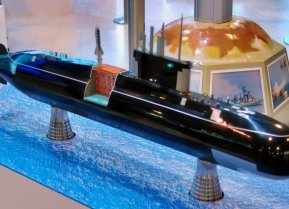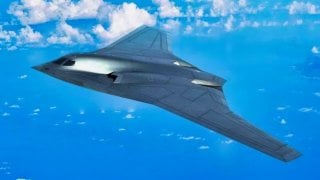China's H-20 Stealth Bomber: Could We Soon See It Fly?
No one really knows the capabilities of China's new H-20 stealth bomber. However, a test flight could change all of that.
Meet China's new H-20 Stealth Bomber: Northeast Asia is one of Earth’s most strategically important regions. Densely populated with people, and with valuable natural resources, Northeast Asia is a hub of industry with global relevance. Accordingly, the world’s most powerful nation, the United States of America, pays attention to Northeast Asia – especially given the potential of China to become a hegemon in the region.
China’s rise may well be beyond stopping. China is the world’s most populated country, with the second largest GDP (beyond only the US). Yet, China has the latent economic potential to overtake the US as the world’s largest economy. China’s rapidly ageing population – the result of the country’s population controlling “one-child” policy – may hinder China’s ascent. Still, China’s appears bent on a revisionist agenda, which warrants special interest from the status quo guarding US.
China’s military ambition
Given China’s revisionist agenda – which benefits from the country’s massive population and latent economic potential – it makes sense that Xi Jinping has made efforts to improve the country’s military.
China’s military might starts with the size of their population; despite an aging population, China can field a massive military. And to complement the massive military, China has committed to improve their military technology.
China uses a variety of methods to improve its military technology. Collaboration: through importing and licensing Russian technology. Theft: through the industrial espionage of American technology. And, to China’s credit, some homegrown domestic effort, too. The result has been a spattering of new weapons that has the US on edge. Hypersonic missiles, for example, which fly fast enough to thwart conventional missile defenses.
Fifth-generation fighters, like the Chengdu J-20, which could prove a match for US fighters like the F-22 and F-35. The Type 003 Fujian aircraft carrier, which could allow China to project air power offshore, throughout the Indo-Pacific. The Type 055 Renhai-class guided-missile cruisers, which have been called “amongst the most formidable warships afloat.” And the Xi’an (XAC) H-20 stealth bomber – a weapon with the potential to impact the strategic balance.
H-20 Stealth Bomber
The H-20 is in development, and accordingly, little is known about the project. Still, the project is concerning; the H-20 is slated to be China’s first stealth bomber. Actually, the H-20 would represent the world’s first non-American stealth bomber.
To date, the US’s B-2 (and forthcoming B-21) are the world’s only stealth bombers, which give the US the world’s most formidable nuclear triad – and a notable advantage with respect to nuclear deterrence.
The development of the H-20 was revealed in 2016, when People’s Liberation Army Air Force (PLAAF) general Ma Xiaotian announced that China was working on a new long-range bomber. Two years later, in 2018, a Chinese military spokesperson said that the H-20 project was making “great progress.”
The H-20 is expected to feature a flying-wing design, much like the B-2 and B-21.
“It’s thought that work on the H-20 began at XAC’s 603 Aircraft Design Institute in the early 2000s,” The Drive reported, “and that both subsonic flying-wing and supersonic delta-wing configurations were studied and yielded several scale models. It seems that by around 2011, the designers had settled on a subsonic flying wing, likely with four engines.”
XAC has experience with the flying-wing design, having previously designed the GJ-11 Sharp Sword combat drone. The GJ-11 likely provided XAC with valuable insights into a flying wing’s flight-control systems and stealth capabilities. The GJ-11 insights could help XAC cross the strategic bomber threshold, giving China it’s first ever foil to America’s stealth bombers, which according to the RAND corporation, would allow China “to reliably threaten U.S. targets within and beyond the Second Island Chian, to include key U.S. military bases in Guam and Hawaii.”
The H-20 is expected to provide the Chinese military with a significant advance over their existing strategic bomber option, XAC’s H-6.

“All in all, the H-20 should represent an enormous advance over the later variants of the XAC H-6 that currently make up the PLAAF long-range bomber fleet,” The Drive reported. “Despite the more recent addition of modern cruise missiles, as well as air-launched ballistic missiles and possible hypersonic weapons, the H-6 design dates back to the Soviet Tu-16 Badger of the early 1950s.” Meaning, the X-6 has long since been outdated. And while the H-6 still has the ability to serve reliably as a bomb truck (akin to America’s 1950s-designed B-52 bomber) the H-20 would be a massive improvement, offering “far greater capabilities as a long-range strategic platform, including in the nuclear deterrent role.”

Reports indicate that the H-20 could take its first flight in the near future. And while full-scale production of the H-20 may still be a few years off, the intent of the Chinese to augment their military abilities seems clear.
About the Author
Harrison Kass is a defense and national security writer with over 1,000 total pieces on issues involving global affairs. An attorney, pilot, guitarist, and minor pro hockey player, Harrison joined the US Air Force as a Pilot Trainee but was medically discharged. Harrison holds a BA from Lake Forest College, a JD from the University of Oregon, and an MA from New York University.
All images are Creative Commons.


